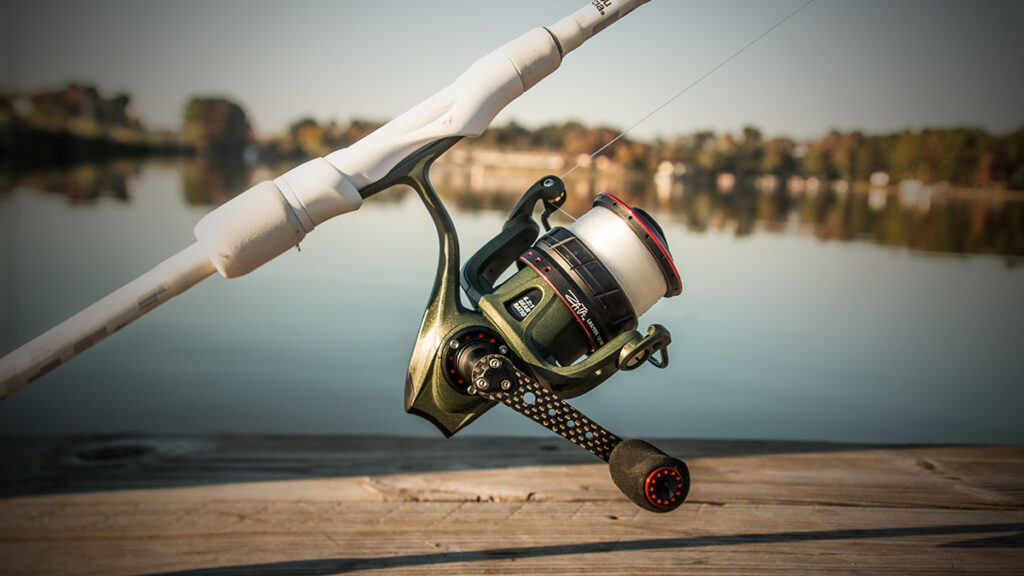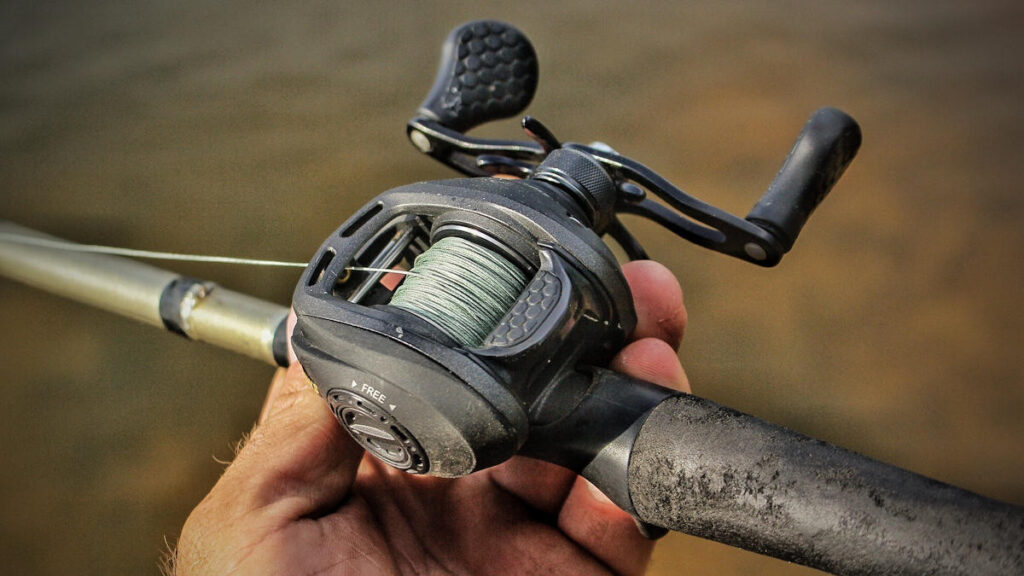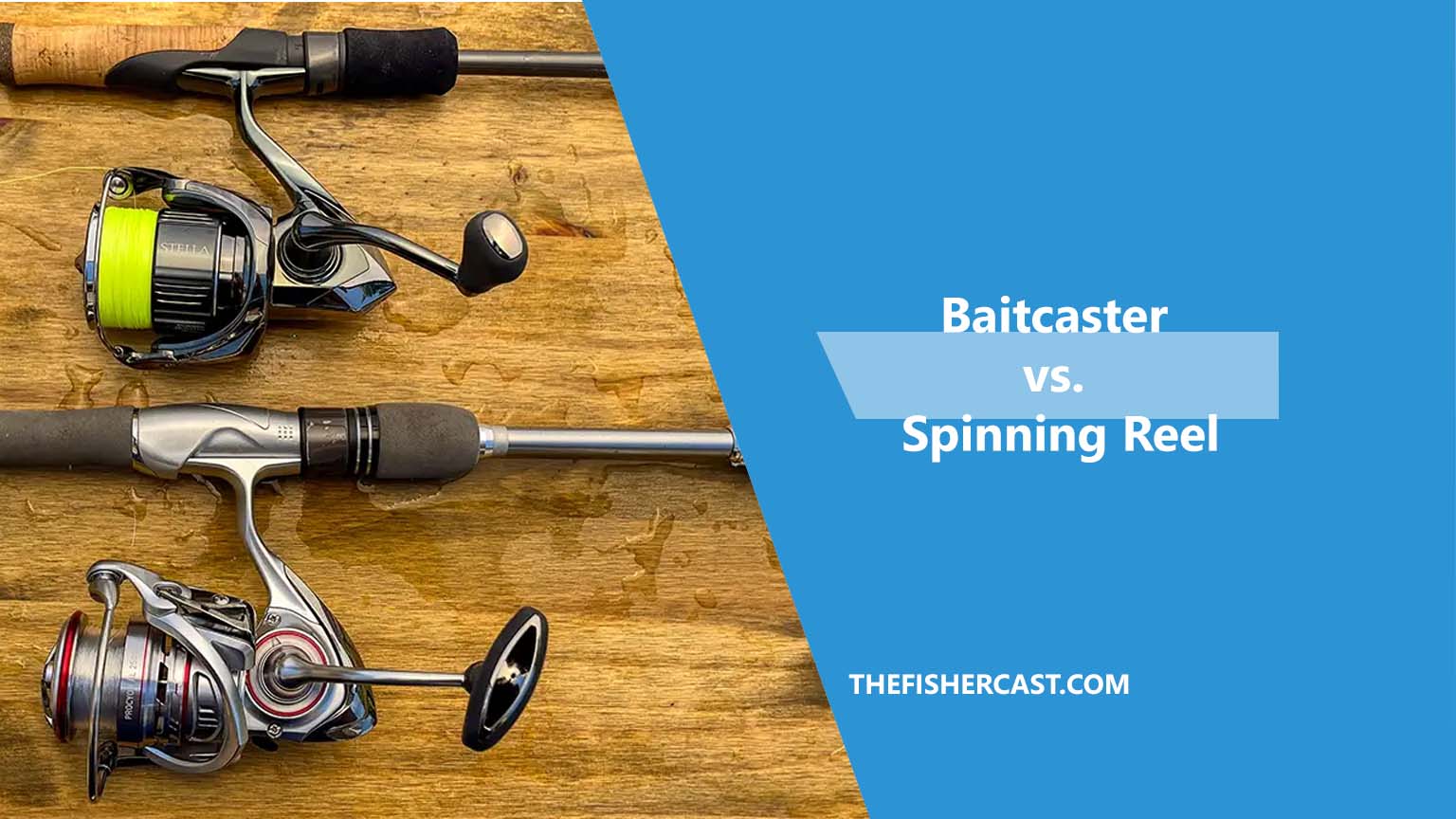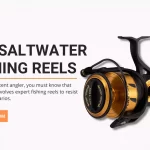Though we might all see this as a battle, here is the reality check it’s a win-win. Let us tell you why? Because both are tools for fishing and are used vastly around as other types of fishing reels. They both get the work done. However, it is their difficulty level and the circumstances they are used in, that should be discussed. Under this informative piece, you will get to know the basics of both reels and will be able to conclude what suits you best. So sit back, relax, take a cup of coffee, and enjoy this reel talk!
Contents
Spinning Reel, an Engineering Marvel of Piscatorial Prowess
Before digging deep into the debate of spinning reel vs baitcaster, let’s grip some basics with fun.
A spinning reel operates on the principle of an open-faced, fixed spool system. Its innovative architecture involves a stationary spool, aligned parallel to the rod, which gracefully unwinds the fishing line during a cast. The line is guided by a rotating bail, resembling a conductor’s baton that artfully orchestrates the movement, ensuring a seamless flow.
One of the spinning reel’s distinctive features is its magical ability to release line effortlessly. Equipped with a finely tuned drag system, reminiscent of an invisible force, it allows anglers to control the tension with impeccable finesse. This exquisite mechanism grants the angler the power to tame the wildest of adversaries, harmonizing the delicate balance between resistance and liberation.

Understanding the Technicality of Spinning Reels:
As to understand how to use a spinning reel, first you need to know the spinning reel in detail.
- Spool: The spool is the part of the spinning reel that holds the line. It is usually made of aluminum or graphite, and it has a blip on the edge that helps to keep the line from slipping.
- Bail: The bail is the metal arm that folds down to allow the line to be released during casting. It is held in place by a spring, and it can be opened and closed with a lever.
- Centrifugal force: Centrifugal force is the force that pushes objects away from the center of a rotating object. In a spinning reel, the centrifugal force created by the spinning spool helps to hold the line in place.
- Drag: The drag is a system that allows the line to be released under controlled conditions. This is important for fighting fish, as it prevents the line from breaking.
Let us summarize this in an easy way for you:
- Spinning reels are like the wings of a bird, allowing anglers to soar through the air and cast their lines far and wide.
- The bail is like the door of a castle, opening, and closing to allow the line to flow freely or be held in place.
- The spool is like a spinning top, spinning with great speed and precision to deliver the line to its target.
- The centrifugal force is like the power of the wind, holding the line in place and preventing it from slipping.
- The drag is like the grip of a lion, allowing anglers to control the fish and prevent it from breaking the line.
The Pros and Cons of Spinning Reels: A Balanced Look
| Pros | Cons |
| Easy to use | Can be prone to backlash |
| Versatile | Can be difficult to cast long distances |
| Affordable | Not as durable as baitcasters |
| Can be used with a variety of lures and baits | Not as good for trolling or jigging |
| Ideal for beginners | Not as good for experienced anglers who need more control |
*Again these pros and cons are according to the preference of the individual, they might vary from fisher to fisher. However, there are a variety of best spinning reels, which can accommodate beginners to advanced levels of fishermen.
Baitcaster, a True Maestro of Angling Innovation
For understanding baitcaster vs spinning reel, it is important to understand baitcaster and how to use baitcaster.
Baitcaster can be likened to the conductor of a symphony orchestra. With its intricate mechanisms and commanding presence, this reel orchestrates a harmonious performance on the fishing stage, captivating both angler and quarry alike.
At its heart, the baitcaster employs a spool-tensioning system akin to the precise tuning of musical instruments. It features a revolving spool nestled snugly within its metallic frame, evoking the image of a conductor’s podium. This dynamic reel operates on the principle of controlled spool rotation, deftly managed by the angler’s skillful hand.
With the baitcaster, one marvels at its symphony of technological marvels. A centrifugal or magnetic braking system, reminiscent of the conductor’s baton controlling tempo, governs the spool’s rotation speed, ensuring smooth and accurate casting. This virtuoso mechanism harmonizes centrifugal forces with magnetic resistance, affording the angler unparalleled control over the bait’s trajectory.

Understanding the Technicality of Baitcaster
As to understand how to use a baitcaster, first you need to know the baitcaster in detail.
- Spool: The spool is the part of the baitcasting reel that holds the line. It is usually made of aluminum or graphite, and it has a lip on the edge that helps to keep the line from slipping.
- Centrifugal force: Centrifugal force is the force that pushes objects away from the center of a rotating object. In a baitcaster, the centrifugal force created by the spinning spool helps to hold the line in place.
- Magnetic brakes: Magnetic brakes are a type of braking system that uses magnets to slow down the spool during casting. This helps to prevent backlash, which is a common problem with baitcasters.
- Spool tension: Spool tension is a setting that controls how much pressure is applied to the spool during casting. This helps to prevent backlash and to ensure that the line is released smoothly.
- Drag: The drag is a system that allows the line to be released under controlled conditions. This is important for fighting fish, as it prevents the line from breaking.
Let us summarize this in an easy way for you:
- Baitcasters are like the hands of a surgeon, precise and delicate.
- The spool is like a spinning top, spinning with great speed and precision to deliver the line to its target.
- The centrifugal force is like the power of the wind, holding the line in place and preventing it from slipping.
- The magnetic brakes are like the hands of a conductor, gently guiding the spool to its final destination.
- The spool tension is like the bowstring of a bow, providing the necessary force to propel the line forward.
- The drag is like the grip of a lion, allowing anglers to control the fish and prevent it from breaking the line.
The Pros and Cons of Baitcasters: A Balanced Look
| Pros | Cons |
| Can cast long distances | Can be prone to backlash |
| More control over the casting process | Can be difficult to learn how to use |
| Versatile | Can be more expensive than spinning reels |
| Ideal for experienced anglers | Not as good for beginners |
*However, it is up to the person and can see some cons in his/her favor. As far as expensiveness of baitcasters is concerned, you can still look for the best baitcasting reels under $100 in the market.
Matching Preferences to Performance: Baitcasters vs Spinning Reels
Here’s a detailed breakdown of individual preferences that may align with either spinning reels or baitcasters:
Spinning Reels:
Beginner-Friendly: Spinning reels are often favored by novice anglers due to their ease of use and forgiving nature. The open-face design, lack of backlash, and simpler casting mechanics make them more accessible for beginners learning casting techniques. These are also budget-friendly, one can easily find the best spinning reels under $100 available in the market.
Versatility: Spinning reels are highly versatile and can handle a wide range of fishing techniques and species. They excel in finesse fishing, light to medium tackle applications, and situations where precise presentations are key.
Line Management: Anglers who prioritize line management and reducing the risk of tangles may lean towards spinning reels. The bail system and larger line guides on spinning reels minimize line twists and allow for smooth line release during casting and retrieval.
Lightweight and Compact: Spinning reels are generally lighter and more compact than baitcasters, making them comfortable for long fishing sessions. Anglers who prefer a more lightweight setup or need to carry multiple rods may lean towards spinning reels.
Casting Distance: While baitcasters can achieve longer casting distances in skilled hands, spinning reels are often favored in situations where casting distance is not the primary concern. If precise casting accuracy and shorter to medium-range casts are the focus, spinning reels can be a suitable choice.
Baitcasters:
Casting Control: Experienced anglers who prioritize casting accuracy and control may lean toward baitcasters. Once mastered, baitcasters offer more precise casting capabilities, allowing for long-distance and targeted casts, especially in situations where accuracy is crucial, such as pitching or flipping techniques.
Heavy Tackle and Large Fish: Baitcasters excel in handling heavier lines, lures, and larger fish due to their robust construction and stronger drag systems. Anglers targeting big game fish or using heavy tackle setups may prefer the increased power and line capacity of baitcasters. Also, according to your fish preference, you can choose from the best baitcasting reels in order to elevate your fishing experience.
Lure Manipulation: Baitcasters offer better control over lure manipulation, especially for techniques requiring frequent stops, starts, or sudden changes in direction. The direct drive and fine-tuning of the spool’s braking system make baitcasters more suitable for certain lure presentations, such as jerk baits or topwater lures.
Angler Skill and Experience: Baitcasters require more skill and practice to master casting techniques and avoid backlash or bird’s nest formations. Experienced anglers who enjoy the challenge and have invested time in refining their casting skills often appreciate the fine-tuned control and precision that baitcasters offer.
Heavy Cover Fishing: When fishing in dense cover or around obstacles, baitcasters’ ability to handle heavier lines and provide more accurate casts makes them preferred choices. The increased control and power allow anglers to maneuver fish out of heavy cover more effectively.
Remember, individual preferences can vary, and there is no one-size-fits-all answer. Some anglers may enjoy using both spinning reels and baitcasters, utilizing each for specific fishing situations, techniques, or personal preferences. Ultimately, it’s important to consider your skill level, fishing objectives, target species, and specific fishing conditions to determine which reel type best suits your individual needs.
Hence, the battle of spinning reel vs baitcaster resolves here, however, it is unlikely to end anytime soon. But we assure you that with all this information you can at least win an argument!

Hi, I am David. I have founded THE FISHER CAST because I believe everybody deserve to do fishing smartly. I with my team are here to make this possible for our present and future generations by giving the best hands on practical experiences and reviews.


![10 Best Spinning Reels Under $100 [2023 Reviews] Best Spinning Reels Under 100](https://thefishercast.com/wp-content/uploads/2022/01/Best-Spinning-Reels-Under-100-150x150.webp)
![10 Best Trout Spinning Reels [Reviews and Buying Guide 2023] Best Trout Spinning Reels](https://thefishercast.com/wp-content/uploads/2022/02/Best-Trout-Spinning-Reels-150x150.webp)
![10 Best Line Counter Reels [2023 Buying Guide & Reviews] Best Line Counter Reels](https://thefishercast.com/wp-content/uploads/2022/02/Best-Line-Counter-Reels-150x150.webp)

![10 Best Spinning Reels [2023 Reviews] Best Spinning Reels](https://thefishercast.com/wp-content/uploads/2022/01/Best-Spinning-Reels-150x150.webp)
